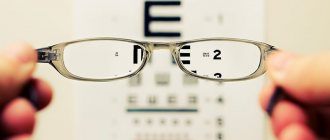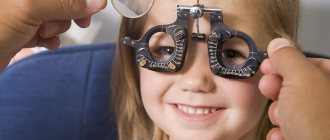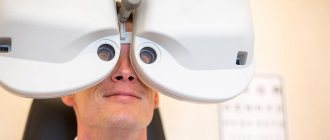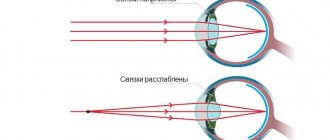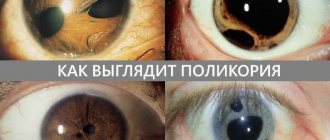Presbyopia or, as people say, “senile farsightedness” appears in people after 40 years of age. The term presbyopia comes from the Greek preybuc, meaning “old man,” and the Latin opia, “short-sightedness,” and the full translation of the word is “old eyes.”
Presbyopia is the inability to clearly see objects around you or read without glasses. Those. everything that is nearby appears blurry. Therefore, people with senile farsightedness have difficulty reading small text, writing, embroidering, knitting, etc. But long-distance vision remains good.
1
Presbyopia (age-related vision loss)
2 Presbyopia (age-related vision loss)
3 Presbyopia (age-related vision loss)
As the name suggests, presbyopia occurs mainly in older people. One of the causes of this disease lies in age-related changes in the lens of the eye. Other causes of age-related vision loss that can provoke this disease are diseases such as diabetes, hypertension, atherosclerosis and multiple sclerosis. Risk factors for the development of presbyopia include working with increased eye strain.
Every year the number of people suffering from presbyopia is increasing. According to experts from the University of California, in three years there will be more than 2.5 billion such people.
How does presbyopia occur?
With age, the lens of the eye loses its elasticity, loses its ability to change shape and correctly focus vision on the retina. As a result, in senile and other types of farsightedness, the focus of vision is behind the retina.
In some people, presbyopia is complicated by cataracts (clouding of the lens), which reduces visual acuity even further.
1 Diagnosis and treatment of presbyopia
2 Diagnosis and treatment of presbyopia
3 Diagnosis and treatment of presbyopia
Symptoms of presbyopia
In adults, presbyopia develops in both eyes. The disease begins with the fact that a person begins to see small text worse, especially in poor lighting.
At the same time, distance vision remains quite clear. To compensate for the lack of vision, a person begins to read small text, holding a newspaper or book at arm's length. It is no coincidence that senile farsightedness is also called “short-arm disease.”
Constant eye strain when working and reading leads to fatigue, double vision, headaches, discomfort in the eyeballs, and drowsiness. In dimly lit rooms, people with presbyopia have very blurred vision. But in bright light, they note an improvement in vision, which is associated with reflex dilation of the pupil.
Interestingly, presbyopia is detected differently in patients with myopia and farsightedness. If there was slight myopia, about 1-2 diopters, both processes are compensated, and such a person will see normally at close and far distances.
When presbyopia appears, a patient with myopia of 3 to 5 diopters also has good vision. He may not wear glasses when reading, but wear them for distance reading.
However, if a person has congenital farsightedness, when presbyopia appears, he will see quite poorly both near and far.
Risk factors:
- age over 40 years;
- previous eye surgery;
- work associated with constant visual stress;
- systemic diseases (cardiovascular diseases, diabetes mellitus, various myopathies);
- acute infectious diseases (flu, measles, meningitis, herpes, mumps);
- constant use of diuretics, tranquilizers, anticonvulsants, antipsychotics and other medications;
- female gender (this pathology occurs more often in women than in men);
- malnutrition.
Correction of presbyopia - wearing plus glasses
The traditional option - wearing plus glasses - perfectly solves the problem of presbyopia in people with any optical visual impairment. Previously, you may have been prescribed two pairs of glasses - one for distance, one for work. Existing glasses allow you to see perfectly at all distances, i.e. you can get by with one pair of glasses. Because presbyopia will continue to worsen until age 65 to 70, you will need to replace your reading glasses approximately every five years.
Nowadays, the development of refractive surgery makes it possible to help young active people aged 40 or more who do not want to wear glasses for any reason, offering several different options for solving the problem.
Laser correction of presbyopia.
One of the first and highly effective ways to correct presbyopia. During laser vision correction using the LASIK method, the correction program is implemented according to the “monovision” scheme. This means that the patient’s dominant eye is adjusted for maximum distance vision, and in the second eye a mild myopia situation is artificially created, approximately -2.0 -3.0 diopters, which allows this eye to do without glasses when working at close range.
Thus, if earlier both of your eyes worked in pairs when looking at objects far and near, now one eye will always be “for company,” resting while the other eye is working.
Not every patient will be able to tolerate this condition. This is due to two factors:
- Firstly, not everyone can be satisfied with the quality of vision when working with one eye.
- Secondly, the human brain is able to comfortably tolerate a difference of 2-3 diopters, since images of different sizes are formed on the retina.
Fortunately for patients, this situation can be easily simulated at a doctor's appointment simply by wearing the right contact lenses. If the patient is comfortable with his new condition, LASIK vision correction using the monovision program can be discussed with your surgeon.
Laser thermokeratoplasty and monovision
This technique is also carried out according to the “monovision” program and is suitable for patients who have had good distance vision all their lives.
Laser thermokeratoplasty is a refractive surgery technique that uses heat from low-energy radio waves to reshape the cornea for good near vision. This method allows you to correct a mild degree of hypermetropia and get rid of reading glasses when presbyopia occurs after 40 years.
During LTK, the eye surgeon uses a special instrument with a very thin tip, with which he applies microcoagulants to the peripheral surface of the cornea in a special order. During thermal exposure of the cornea, the collagen fibers of the cornea contract. The shortening of collagen fibers along the periphery results in the formation of a more convex corneal surface in the center, which increases its optical power and shifts the focus to the retina. The LTK procedure takes a few minutes and, unlike LASIK or PRK, does not involve the removal of corneal tissue.
Despite the fact that LTK gives a long-lasting effect, its effect is not constant. The reasons for the inconsistent effect of LTK are the progression of presbyopia.
Replacing clear lenses
One of the options for surgical correction of presbyopia involves the removal of clear lenses with the installation of multifocal IOLs. The operation is identical to cataract surgery and is easier than removing age-related cataracts due to the softness of the lens. Modern multifocal artificial lenses allow you to see clearly at any distance. Replacing clear lenses can solve all problems with refractive errors in a patient, regardless of its degree.
Diagnosis of presbyopia
To make an accurate diagnosis of a patient with vision problems and identify presbyopia, the following studies are performed:
- ophthalmoscopy;
- study of accommodation capabilities;
- study of visual acuity at different distances;
- tonometry,
- other laboratory and instrumental studies.
1 Diagnosis and treatment of presbyopia
2 Diagnosis and treatment of presbyopia
3 Diagnosis and treatment of presbyopia
The main set of exercises for presbyopia
These exercises should strengthen the oblique oculomotor muscles while increasing their mobility and relieve chronic tension in the rectus oculi muscles to improve ocular accommodation. The location and directions of movement of these muscles are shown in the diagram.
Training any muscles is most effective when they are statically tensed for 5-6 seconds, followed by complete relaxation and new tension after a few seconds. This is exactly how you need to train weakened oblique muscles of the eyes (exercises 1 - 4). For chronically contracted rectus muscles, on the contrary, dynamic exercises are useful to increase the mobility (flexibility, softness) of the muscles (exercises 5 - 8).
The complex also includes exercises to increase the flexibility and performance of the ciliary muscle (exercises 9 and 10) and a convergence exercise (gaze, 11).
If you have presbyopia, all exercises should be done 5-7 times a day (not necessarily in a row), but exercises 1,2,5,7 and 8 are best done more often. When performing exercises, be careful: do not let your eyes get tired, do not allow pain, pain or other discomfort, try to relax as much as possible all the external and internal muscles of the eyes that do not work in this exercise, achieve a gradual increase in the smoothness and amplitude of movements, replace tension with attention, looking at objects in static positions of the eyeball. Give more time and attention to the eye that sees worse, doing more repetitions of the exercises (the other eye can be covered with your hand). High-quality exercises should gradually reduce deviations from normal vision.
The starting position corresponds to correct posture: the head is turned so that the top of it looks up; shoulders, neck, facial muscles and eyes are relaxed; the gaze is directed forward.
1. Smoothly move your gaze from the center to the upper right corner. It should be exactly above your right shoulder. Move your gaze in that direction as far as you can without pain. Try to carefully, but without tension, examine what is in this corner. Look at the object for 5-6 seconds, then smoothly return your gaze to its original position. After a few seconds, repeat this contraction of the superior oblique muscle of the right eye.
2. Do the same careful consideration of what is in the upper left corner to train the superior oblique muscle of the left eye.
3. To strengthen the inferior oblique muscle of the right eye, gently move your gaze to the edge of your right shoulder to carefully and relaxedly examine it for 5-6 seconds. Then gently return your gaze to the starting position.
4. In the same way, glance at your left shoulder and carefully examine it for 5-6 seconds.
5. Smoothly, without moving your head, move your gaze upward as you exhale. You will see your eyebrows and what is at an angular distance close to them. Without pausing, also gently return your gaze to the starting position. As you exhale, look up again. With smooth, almost pendulum movements, lift your gaze as high as possible (within the limits of what is comfortable and painless) up and lower it to the starting position. Try to avoid speeding up and jerking your eye movements.
6. In the same way, exhale, smoothly move your gaze all the way down and, without pausing, return your gaze to its original position.
7. Smoothly, as you begin to exhale, move your gaze all the way to the right. The left eye will simultaneously see the nose. Without stopping, slowly return to the starting position. You seem to swing your gaze, as if on a swing: to the right and back, ever softer, ever further. Make sure that as you move to the right, you do not lower your gaze, moving the inferior oblique muscle of the right eye.
8. In the same way, move your gaze all the way to the left and return to the starting position. The nose now sees the right eye.
The first eight exercises of the complex can be done separately for one, worse-seeing eye, covering the second eye with your hand.
9. Stick a small piece of paper on the glass of the window. Draw a bold cross or other clear sign on it. Stand opposite the window at the maximum distance so that you can still see the sign clearly, and move a little closer to the window. Cover one eye with your hand. Look either at the sign or through the window into the distance, trying to move your gaze as smoothly as possible. Staying on the sign for 5-6 seconds, try to see it clearly. Don't pull your head back or tense up. Try to ensure the clarity of the image. Help the eye mentally, as if drawing the sign towards you (or draw it into yourself along with your inhalation). After training the muscles of one eye, close it with your hand and train the other. Don't forget to give your eyes time to rest. If there is such an opportunity (for example, a bush outside the window), look into the distance, gradually increasing the distance and also then decreasing it, returning your gaze to the sign. Curtains or blinds can also be used for this purpose. Through open blinds or through tulle, you can view distant objects, the mark on the window, and themselves.
10. Take in your hand some object that you can clearly see in all details at least at arm's length. Slowly bring the object closer to your eyes. Go slightly beyond the limit of clarity of vision. Stop the movement and try to get a clear image. Give your eyes a rest, then move it closer to you again. You may physically feel the resistance of your eyes to the approach of an object. Make sure your eye muscles are relaxed and don’t squint. Don't let the image blur for a long time and don't force things by bringing the subject too close to your eyes. Help your eyes psychologically by mentally pulling the object towards you.
Do the same for one eye, covering the other eye with your hand, then change the training eye. Do the exercise either for two eyes together, or for each of them separately, devoting more time to the eye that sees worse.
11. While exhaling, focus your gaze on the bridge of your nose for 5 seconds (yogis call this place the third eye), then smoothly move your gaze in an arc for a few seconds into the distance - at this time you can inhale, then, while exhaling, look for 5 seconds at the tip of your nose and again look into the distance, then again to the bridge of your nose, and so on.
Don't let your eyes get tired. Pause or stop exercising if you feel discomfort. If necessary, regularly use various methods of resting and relaxing your eyes, including audio recordings.
Like
Presbyopia treatment
It is impossible to cure presbyopia with conservative methods alone. But with the help of glasses and lenses, vision correction for presbyopia is possible.
A good option for such patients is glasses with bifocal lenses , in which the upper part of the lenses allows you to see distant objects, and the lower part allows you to see close objects.
There are also progressive lenses that help you see at any distance.
Contact lenses are also used to treat presbyopia. Typically, in such cases, multifocal lenses or a combination of different lenses are selected to create monovision (one eye will see well near, and the other eye will see at a distance).
At the request of the patient, surgical treatment of age-related vision loss can be performed.
The following surgical techniques can be noted:
- Lens replacement —carried out if the patient additionally has clouding of the lens, i.e. cataract;
- laser thermokeratoplasty - the use of a laser to change the curvature of the cornea;
- implantation of intraocular lenses.
Visual gymnastics
At the initial stage of presbyopia, the treatment method is eye exercises. They can improve vision and slow down the progression of the disease. Many visual gymnastics complexes have been developed, one of the options is given below:
- sit on a chair, lean back, closing your eyes at the same time, then straighten up and open your eyes;
- turn the body to the right and left, “following” the turns with your eyes;
- roll your eyes around.
Each exercise is performed for 10-15 approaches. Gymnastics are done daily, the effect becomes noticeable after 2-3 weeks.
In the following review, experts will tell you what nuances there are when performing eye gymnastics:
Correction of presbyopia begins as early as possible. This allows you to slow down the progression of the disease and maintain a person’s ability to work. Conservative methods provide a temporary effect, while surgical methods can radically correct presbyopia.
Leave comments on the article. Tell your friends about it on social networks, the information may be useful to them. All the best.
How to recognize the symptoms of presbyopia
Age-related farsightedness is caused by natural changes in the lens and intraocular muscles. Over the course of life, the lens gradually wears out, loses elasticity and the ability to quickly change shape to correctly project images onto the retina. If other refractive errors are caused by both genetic and acquired factors, presbyopia has one justification - age.
Presbyopia is characterized by blurred and unclear vision when working at close range. Discomfort causes a person to strain their eyes, and it becomes more difficult to achieve concentration and focus. Reading, working on a computer, watching TV and doing handicrafts cause visual discomfort, headaches and increased fatigue.
Prevention
To prevent presbyopia, you need to follow simple recommendations:
- observe the work and rest schedule;
- reduce visual stress;
- lead a healthy lifestyle;
- avoid negative environmental influences;
- Treat eye diseases and the whole body in a timely manner.
To maintain eye health for a long time, do not forget to perform special exercises:
- Charging to restore vision
- Gymnastics according to Avetisov
- Prevention of visual impairment
Preventing presbyopia
Unfortunately, it is impossible to prevent age-related farsightedness. The lens wears out in everyone without exception, gradually losing its optical properties. But it is still possible to delay the onset of presbyopia.
To ensure that the vision defect is mild in the future, you need to carefully observe visual hygiene and not overstrain your eyes. A balanced diet, including vitamins A, B and C, will strengthen the visual system, and eye exercises will train the muscles of the eyeballs. Even if a person constantly works at a computer and reads, but provides comfortable conditions and proper lighting, vision will not deteriorate.
It's easy to help your eyes:
- do not sit at the computer in the dark;
- use computer glasses;
- rest every half hour;
- massage the eyelids;
- do a neck massage;
- put a yellow-orange picture with an endless perspective on your desktop and look at it from time to time;
- make tea lotions that will relieve signs of fatigue and puffiness from the eyes at the end of the day;
- do visual gymnastics.
Every person should undergo preventive examinations twice a year, even if there are no noticeable symptoms of any disease. This is due to the fact that many ophthalmological pathologies occur latently. It is also important to check the functioning of other body systems, because often vascular disorders and infections negatively affect visual function.
Presbyopia is an inevitable but harmless condition. Just as your skin changes with age, your eyes can also wear out. Natural deterioration of vision does not pose a threat to health, but can cause inconvenience.
Sources used:
- Kvasova M. D. Vision and heredity. - Moscow / St. Petersburg: Dilya, 2002.
- Robert Abel, The Eye Care Revolution: Prevent and Reverse Common Vision Problems, Kensington Books, 2004.
- Liberdade C. Salerno, Mauro C. Tiveron, Jr., and Jorge L. Alió. Multifocal Intraocular Lenses: The Art and the Practical
- “Eye Microsurgery” named after Academician S.N. Fedorov" of the Ministry of Health of the Russian Federation

